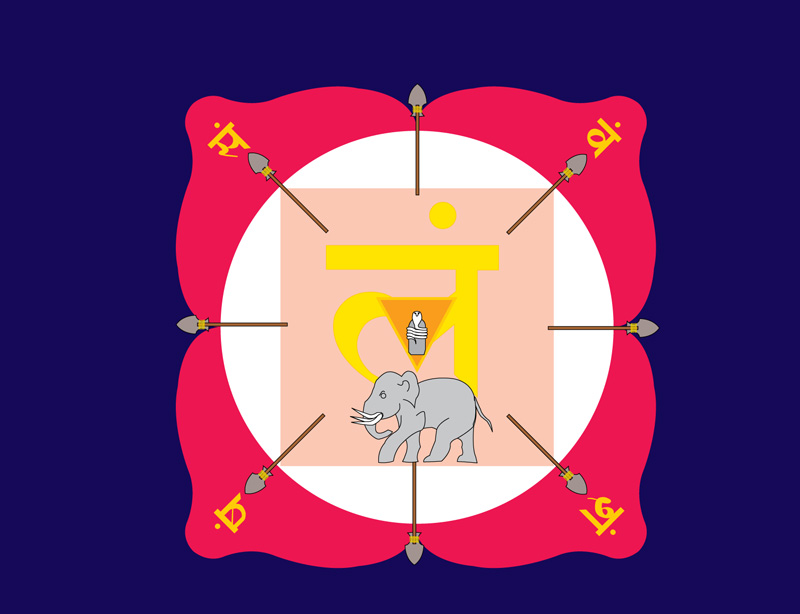Jottings: The Colours of Magic in the Tantras
“In the subjugation, bewitching, and agitation (kṣobha) rites [the deity] should be visualized as red-colored. In rites of subjugation (nirviṣīkaraṇa), pacification, and prosperity increasing rites [the deity] is white. (1.33)
For the immobilization the deity is yellow, in eradication smoky-colored, in bewildering rites color of a cochineal insect [i.e. red like a ladybug], but in the killing rites the deity is black.” (1.34)
Uḍḍiśatantra
I recently listened to Amy Hale give a wonderful lecture on how theories of colour developed in Western Esotericism, I thought it was high time that I had a stab at some notes on the use of colour within the tantric traditions. This is a vast subject, and I’m going to take it slowly.
As part of a recent Twitter discussion regarding the colours that are assigned to various chakra schemas, I recalled this passage from the Kaulajñānanirṇaya (KJN):
“When meditating (on the Cakras) as red, they always give subjugation; as yellow they cause paralysis; as pure crystal they give liberation; as black, death; as smoky they give the power to uproot. When meditating on them as being pure white, like cow’s milk, this is Mṛtyuñjaya (Victory over Death). One may cause excitation, paralysis, trembling, fall from status and forth.”
Kaulajñānanirṇaya, 10, 28-30
This caught my attention for two reasons. Firstly, if I am interpreting the KJN correctly, it implies that the chakras (eight, in this particular section of the text) have no fixed colours for meditation, but that the colour changes according to the results the practitioner wishes to achieve. Secondly, the colours are those associated with the so-called six rites of magic (abhicāra). Again, this is not particularly unusual, and several texts provide instructions for acts of sorcery via meditation on the chakras.
Western chakra schemas tend to assign fixed colours to the different chakras. The colours assigned to chakras in Indian schemas are, as we might expect, considerably more complex. The Saṭcakranirūpaṇa 1 for example, says that “the petals of the Ādhāra chakra are crimson in hue, with the Sanskrit letter on each petal the colour of shining gold 2 Within the chakra, is the elemental square, of shining yellow. Within are Brahma in child-form, mounted on the King of elephants, and he is “resplendent as the young sun” whilst the devī Dakinī, with eyes of brilliant red, is “resplendent like the lustre of many suns rising at one and the same time.” (The Serpent Power, appendix 4, v4-7).

The elemental bhūtamaṇḍalas associated with the chakras are fairly consistent across the different schemas and, as far as I am aware, date back to the earliest chakra schemas of the Śaiva Siddhāntas, from around the 7th Century CE.
But what do these colours signify? Red is often associated with passion, vitality, and of course, blood. Yellow, as can be seen from the quotes above, is frequently associated with paralysis, or immobility. White suggests nature (prakṛti), also the coolness of the Moon, and is also associated with rites of appeasement (śānti) and prosperity (puṣṭi). “Smoky” or grey is associated with rituals of eradication (uccāṭana). The goddess Dhūmāvatī – “the smoky one” (one of the Mahāvidyās) is particularly associated with destructive magic and is said to grant the power of destruction of one’s enemies.
Sources
P.C. Bachi (ed), Mike Magee (Transl) Kaulajnana-nirnaya of the school of Matsyendranatha (Prachya Prakashan, 1986)
Gudrun Bühnemann, The Iconography of Hindu Tantric Deities Volume 1: The Pantheon of the Mantramahodadhi (Egbert Forsten, 2000)
David Kinsley Tantric Visions of the Divine Feminine: The Ten Mahavidyas (Motilal Banarsidass, 1998)
Sir John Woodroffe, The Serpent Power, (Ganesh & Co. 1950)
Image from The Huntington Archive of Buddhist and Asian Art
